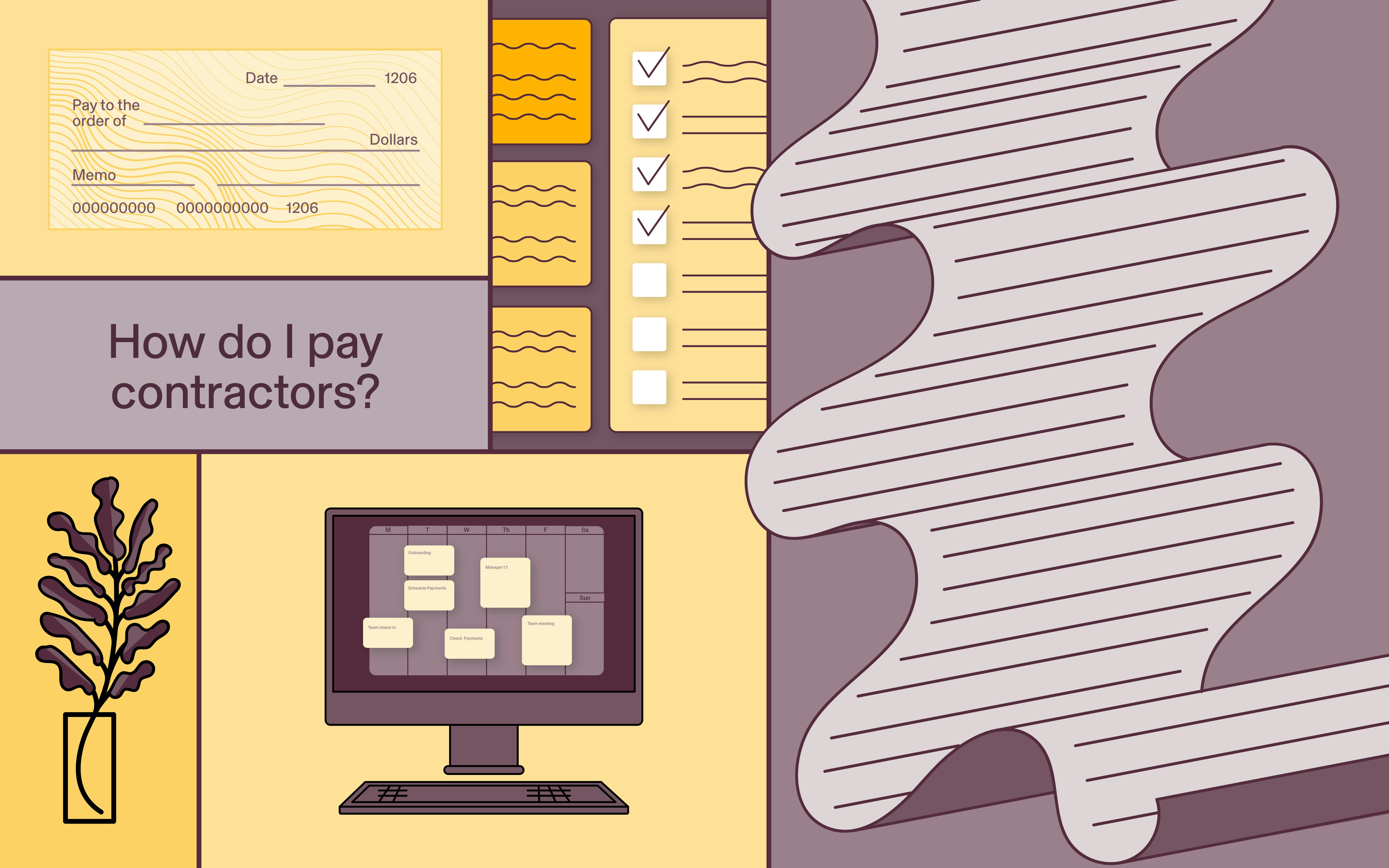Forms 1099 MISC vs. 1099 NEC: What’s the difference?

If you work with independent contractors, you’re likely familiar with Form 1099-NEC, the tax form you send in to report payments made to non-employees every year. Are you aware, however, that, depending on the type of compensation, you may also need to file a Form 1099-MISC? Or that the 1099-NEC actually replaced the 1099-MISC in 2020 as the primary method for reporting taxable, non-employee compensation to the IRS?
What’s the difference between 1099-MISC and 1099-NEC? Who needs to send which form to the IRS? In this article, we’ll answer these questions and more.
The 1099-NEC is a tax form that your business must complete for any non-employee worker who provides services valued at more than $600 in a given year. The ‘NEC’ stands for ‘non-employee compensation.’ Broadly similar to the Form W-2 you would provide to your employees, the 1099-NEC ensures that self-employed contractors and freelancers accurately report their annual income.
Example: Acme Corp. hires a remote team of freelance designers to support a new product launch, each of whom receives $4,500 in compensation for services performed over the course of a three-month contract. At the end of the year, Acme Corp. completes and files a 1099-NEC for each designer.
Example: Bobby’s Shop hires three design assistants to help create new window displays before the holiday season. Two designers receive $500 for ten hours of work over the course of several weeks. The third designer receives $700 for the same amount of work. Bobby’s Shop is only required to complete a 1099-NEC for the design assistant who earned $700 in compensation.
What is a 1099-MISC form?
The 1099-MISC is also a tax form used to report non-compensation payments to non-employee workers or service providers. Because these payments can cover such a wide range of expenses, from attorney’s fees to cash payments for fishing, the IRS uses this form as a catchall for ‘miscellaneous income,’ hence ‘MISC.’
While the 1099-MISC was used to report payments to independent contractors or sole proprietor income before 2020, this is no longer the case.
Example: Alex receives quarterly royalty payments from his publisher for a novel he published last year. His publisher will report these payments using a 1099-MISC.
Example: Bobby’s Shop pays monthly rent to the development company that owns the brick-and-mortar building housing the storefront. These payments are recorded and reported annually on a 100-MISC.
1099-NEC vs. 1099-MISC: Key differences
Understanding the distinction between the 1099-NEC and 1099-MISC ensures that you correctly report your business expenses to the IRS. While these forms have much in common, they serve two different purposes. The below guidelines should help you determine who gets a 1099-NEC and who gets a 1099-MISC.
1099-NEC vs. 1099-MISC: Who files it?
While your self-employed contractors will use the 1099-NEC to complete their annual tax returns, the obligation to complete and file the form falls on you, the business that made the payments, as part of your payroll taxes.
To understand whether you need to issue a 1099-NEC for a particular individual, corporation, partnership, or estate, consider the following:
- Did you request a Form W-9 as part of the hiring process?
- Did the contractor provide professional, paid business services to your organization?
- Did the contractor receive payments in excess of $600 for services performed during the year?
If the answer to all of these questions is ‘yes,’ you should plan to report these payments using a 1099-NEC. If you’re unsure whether someone you’ve worked with counts as an independent contractor or an employee, reach out to the IRS and fill out Form SS-8. They’ll help you determine the right thing to do, and you’ll avoid the headaches that come from employee misclassification.
Note that the IRS considers several different types of payments as ‘non-employment compensation.’ To determine whether you’ve passed the $600 threshold with a particular contractor, you’ll need to calculate the sum of all payments made, including:
- Fees, including referral fees
- Commissions on sales
- Benefits, if your business subsidizes expenses or ad hoc equipment and material needs for contractors
- Bonuses for work performed
While the 1099-NEC does include items for state and federal tax withholdings, these typically won't apply to your self-employed contractors. For more guidance, refer to our guide to payroll taxes for small businesses.
If you’ve made a payment equal to more than $600 to a non-employee, and those payments don’t qualify as fees, commissions, benefits, or bonuses, the 1099-MISC may be the correct form for reporting. The 1099-MISC covers all other types of payments, which is why the IRS included ‘miscellaneous’ in its name.
Types of payments your business would report with a Form 1099-MISC include, among others:
- Royalties
- Rents
- Federal income tax withheld
- State tax withheld
- Gross proceeds paid to an attorney
- Medical and health care payments
- Fishing boat proceeds
- Fish purchased for resale
- Crop insurance proceeds
- Direct sales totaling $5,000 or more of consumer products to recipient for resale
- Substitute payments in placement of dividends or interest
- Excess golden parachute payments
- Nonqualified deferred compensation
1099-NEC vs. 1099-MISC: Deadlines
The IRS uses different filing deadlines for the 1099-NEC and 1099-MISC, so it’s important to begin classifying your self-employed workers and calculating payments well in advance to avoid a last-minute rush to file.
- 1099-NEC Deadline: You must submit this form to the IRS by January 31st each year, whether you file electronically or in hard copy. Unless you can prove some sort of hardship or rare exception to the rule, there are no extensions. This is a hard deadline you shouldn’t miss.
- 1099-MISC Deadline: According to the IRS, if you file 1099-MISC on paper, the deadline is February 28th. If you submit your 1099-MISC electronically, the deadline is March 31st.
The IRS is well known for imposing penalties on taxpayers who miss form submission or payment deadlines, so take care. If possible, consider investing in an automated payroll system that automatically generates and files these forms on your behalf.
1099-NEC vs. 1099-MISC: Penalties
In the event that you miss a filing deadline or payment due date or misreport your income, the IRS may apply a penalty. In the case of the 1099-NEC and 1099-MISC, the consequences of a mistake are the same:
- Missing the deadline: The amount of the penalty depends on how much time has passed since the filing deadline and can range from $60 to $310 per form. The penalty goes up if the agency determines that you knew about the deadline and ignored it. Businesses that find themselves in hot water will pay a minimum of $630 per return.
- Failing to report the full amount of income: It's crucial to make sure you keep careful, detailed records of all the income paid to your contractors so you don't erroneously report their wages.
An automated payroll solution like Rippling can provide valuable peace of mind when it comes to preparing and filing 1099-NEC and 1099-MISC. From automatically requesting W-9s during onboarding to preparing and filing these important forms without the need for human intervention, an automated system removes the possibility for human error and streamlines your compliance process.
How to file a 1099 form for a contractor
If your business manually manages preparation and filing for your Forms 1099-NEC and 1099-MISC, you’ll need to follow a process to ensure prompt filing and accurate reporting for every tax year.
1099-NEC file process
Here’s how to fill out Form 1099-NEC:
- Step 1: Enter your federal employer ID tax number and your business’s name and address in the correct boxes, which are clearly marked.
- Step 2: Fill out the independent contractor’s information, including their SSN or taxpayer identification number. Also, make sure you have their current mailing address.
- Step 3: Box 1 is for the total amount of money you paid to the independent contractor that year.
- Step 4: Usuall, Box 4 can be left blank since it records the amount you withheld from their paycheck. There’s one exception: If the individual is subject to backup withholding, that amount will go here. There’s no need to guess if this applies to the independent contractor–the IRS is pretty good about altering companies if they need to fill Box 4 out for a particular individual.
- Step 5: Boxes 5, 6, and 7 are for information the state’s taxation department requires, not the IRS. Enter the income the independent contractor received, whether you withheld any state taxes from their paychecks, and which state the report is being sent to. One caveat: If you need to report this information to multiple states, you’ll need to fill out a separate form for each one.
- Step 6: If you’re completing the 1099-NEC online, you have the option to e-file. Paper copies must be mailed, together with a Form 1096 cover sheet, to the IRS.
1099-MISC file process
Here’s how to fill out a Form 1099-MISC:
- Step 1: Enter your federal employer ID tax number and your business’s name and address in the correct boxes, which are clearly marked.
- Step 2: Fill out the contractor or payee’s information, Fill out the independent contractor’s information, including their SSN or taxpayer identification number. You’ll also need a current mailing address.
- Step 3: Boxes 1 through 18 itemize the different types of miscellaneous payments you may have made to the contractor or service provider. Complete as many as apply.
- Step 4: If you’re completing the 1099-MISC online, you can now file electronically. For paper copies, you’ll need to mail your completed forms, together with a Form 1096 cover sheet to the IRS.
1099-NEC and 1099-MISC for international contractors
When working with international contractors, the question of whether to issue a 1099-NEC or a 1099-MISC depends on the nationality of the contractor and the contractor’s location.
For foreign contractors working abroad, you’ll need to request and file a W-8BEN. This certifies to the IRS that the contractor is neither a US citizen nor a US entity and helps the IRS determine your tax obligations with respect to payments made.
For American contractors living abroad and international workers offering services from within the US, you’ll need to file either a 1099-NEC or 1099-MISC. The correct form will depend on the type of payments made.
Simplify 1099-NEC and 1099-MISC compliance with Rippling
Rippling makes complying with all payroll and tax filings straightforward by automatically generating and distributing 1099 tax forms to all qualifying contractors and e-filing with the IRS and even simplifies payments and compliance for international contractors. From identifying and sending the right tax forms to tracking time works, Rippling removes the guesswork from hiring contractors abroad.
This blog is based on information available to Rippling as of ___PUBLISH DATE___.
Disclaimer: Rippling and its affiliates do not provide tax, accounting, or legal advice. This material has been prepared for informational purposes only, and is not intended to provide or be relied on for tax, accounting, or legal advice. You should consult your own tax, accounting, and legal advisors before engaging in any related activities or transactions.








